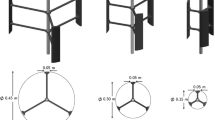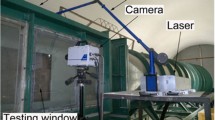Abstract
This work visualizes the flow surrounding a scaled model vertical axis wind turbine at realistic operating conditions. The model closely matches geometric and dynamic properties—tip speed ratio and Reynolds number—of a full-size turbine. The flow is visualized using particle imaging velocimetry (PIV) in the midplane upstream, around, and after (up to 4 turbine diameters downstream) the turbine, as well as a vertical plane behind the turbine. Time-averaged results show an asymmetric wake behind the turbine, regardless of tip speed ratio, with a larger velocity deficit for a higher tip speed ratio. For the higher tip speed ratio, an area of averaged flow reversal is present with a maximum reverse flow of \(-0.04U_\infty\). Phase-averaged vorticity fields—achieved by syncing the PIV system with the rotation of the turbine—show distinct structures form from each turbine blade. There were distinct differences in results by tip speed ratios of 0.9, 1.3, and 2.2 of when in the cycle structures are shed into the wake—switching from two pairs to a single pair of vortices being shed—and how they convect into the wake—the middle tip speed ratio vortices convect downstream inside the wake, while the high tip speed ratio pair is shed into the shear layer of the wake. Finally, results show that the wake structure is much more sensitive to changes in tip speed ratio than to changes in Reynolds number.









Similar content being viewed by others
References
Araya DB, Dabiri JO (2015) A comparison of wake measurements in motor-driven and flow-driven turbine experiments. Exp Fluids 56(7):1–15
Association AWE et al (2012) Awea us wind industry: first quarter 2012 market report
Barsky DA, Posa A, Rahromostaqim M, Leftwich M, Balaras E (2014) Experimental and computational wake characterization of a vertical axis wind turbine. American Institute of Aeronautics and Astronautics. doi:10.2514/6.2014-3141
Barthelmie RJ, Jensen L (2010) Evaluation of wind farm efficiency and wind turbine wakes at the Nysted offshore wind farm. Wind Energy 13(6):573–586
Cal RB, Lebrón J, Castillo L, Kang HS, Meneveau C (2010) Experimental study of the horizontally averaged flow structure in a model wind-turbine array boundary layer. J Renew Sustain Energy 2(013):106
Chan AS, Pa D, Jameson A, Liang C, Smits AJ (2011) Vortex suppression and drag reduction in the wake of counter-rotating cylinders. J Fluid Mech 679:343–382. doi:10.1017/jfm.2011.134
Dabiri J (2011) Potential order-of-magnitude enhancement of wind farm power density via counter-rotating vertical-axis wind turbine arrays. J Renew Sustain Energy 3:043104. doi:10.1063/1.3608170
Grady S, Hussaini M, Abdullah MM (2005) Placement of wind turbines using genetic algorithms. Renew Energy 30(2):259–270
Grasso F, Ceyhan O (2014) Usage of advanced thick airfoils for the outer part of very large offshore turbines. J Phys Conf Ser. doi:10.1088/1742-6596/524/1/012030
Howell R, Qin N, Edwards J, Durrani N (2010) Wind tunnel and numerical study of a small vertical axis wind turbine. Renew Energy 35(2):412–422
Islam M, Ting D, Fartaj A (2008) Aerodynamic models for Darrieus-type straight-bladed vertical axis wind turbines. Renew Sustain Energy Rev 12(4):1087–1109. doi:10.1016/j.rser.2006.10.023
Karabelas S, Koumroglou B, Argyropoulos C, Markatos N (2012) High Reynolds number turbulent flow past a rotating cylinder. Appl Math Model 36:379–398
Kinzel M, Mulligan Q, Dabiri JO (2013) Energy exchange in an array of vertical-axis wind turbines. J Turbul 13(38):1–13
Mittal S, Kumar B (2003) Flow past a rotating cylinder. J Fluid Mech 476:303–334. doi:10.1017/S0022112002002938
Paraschivoiu I (1981) Double-multiple streamtube model for Darrieus wind turbines. In: Second DOE/NASA wind turbines dynamics workshop. NASA CP-2186. Cleveland, OH, pp 19–25
Posa A, Parker CM, Leftwich MC, Balaras E (2016) Wake structure of a single vertical axis wind turbine. Int J Heat Fluid Flow. doi:10.1016/j.ijheatfluidflow.2016.02.002
Strickland JH (1977) A performance prediction model for the darrieus turbine. In: International symposium on wind energy systems, vol 1
Tescione G, Ragni D, He C, Ferreira CS, van Bussel G (2014) Near wake flow analysis of a vertical axis wind turbine by stereoscopic particle image velocimetry. Renew Energy 70:47–61
US Department of Energy (2008) 20 % wind energy by 2030. Tech. rep
Wilson RE, Lissaman PB (1974) Machines power wind of aerodynamics. Tech. rep., Oregon State University, Corvallis (USA)
Acknowledgments
The authors wish to thank Matthew Glasstone and Allen Schultz for their experimental assistance. We thank Antonio Posa and Elias Balaras for much insightful discussion and many helpful suggestions. Thank you to The Metro Washington Chapter of the Achievement Rewards for College Students (ARCS) Foundation and the McNichols Foundation for their financial support of my education.
Author information
Authors and Affiliations
Corresponding author
Electronic supplementary material
Below is the link to the electronic supplementary material.
Supplementary material 1 (mp4 9878 KB)
Supplementary material 2 (mp4 8516 KB)
Supplementary material 3 (mp4 4487 KB)
Rights and permissions
About this article
Cite this article
Parker, C.M., Leftwich, M.C. The effect of tip speed ratio on a vertical axis wind turbine at high Reynolds numbers. Exp Fluids 57, 74 (2016). https://doi.org/10.1007/s00348-016-2155-3
Received:
Revised:
Accepted:
Published:
DOI: https://doi.org/10.1007/s00348-016-2155-3




